Towns That Go Down a Storm
Trinidad, Cuba
by Sarah Shuckburgh
Even when it can't offer
postcard-perfect skies, Cuba has charm to spare, says Sarah
Shuckburgh.
 As we arrive in Havana, a hurricane is approaching from
the west. The Atlantic ocean looks grey and menacing, and
huge waves splash over the 6-mile Malecón seawall. Shops and
galleries are closed, and my friend Orna and I wander the
streets, watching as workmen nail plywood across doors, and
stick parcel-tape on window-panes. Caught in a sudden
shower, we shelter in an aptly-named bar, La Lluvia de Oro –
golden rain. The bar is packed with smiling Habaneros,
shaking maracas and dancing to the music of a nine-piece
band. Hurricanes are part of life for Cubans, and nothing
can dim their extraordinary exuberance. As we arrive in Havana, a hurricane is approaching from
the west. The Atlantic ocean looks grey and menacing, and
huge waves splash over the 6-mile Malecón seawall. Shops and
galleries are closed, and my friend Orna and I wander the
streets, watching as workmen nail plywood across doors, and
stick parcel-tape on window-panes. Caught in a sudden
shower, we shelter in an aptly-named bar, La Lluvia de Oro –
golden rain. The bar is packed with smiling Habaneros,
shaking maracas and dancing to the music of a nine-piece
band. Hurricanes are part of life for Cubans, and nothing
can dim their extraordinary exuberance.
 We
decide to head east, out of the path of the storm. Leaving
Havana, we drive along empty roads, past mango and orange
groves, through straggling villages of one-storey shacks.
People wave at us from their rocking-chairs. Others sit on
their porches having their hair cut, or playing music.
Isolated blocks of flats loom, grey and bleak in the barren
countryside. There is almost no traffic apart from the odd
bicycle, some horse-drawn carts laden with hay, occasional
tractors carrying passengers. Clusters of people wait on
verges and under shady bridges, hoping for a lift. Vultures
wheel in the blustery sky. We
decide to head east, out of the path of the storm. Leaving
Havana, we drive along empty roads, past mango and orange
groves, through straggling villages of one-storey shacks.
People wave at us from their rocking-chairs. Others sit on
their porches having their hair cut, or playing music.
Isolated blocks of flats loom, grey and bleak in the barren
countryside. There is almost no traffic apart from the odd
bicycle, some horse-drawn carts laden with hay, occasional
tractors carrying passengers. Clusters of people wait on
verges and under shady bridges, hoping for a lift. Vultures
wheel in the blustery sky.
After several hours, we cross a scrubby ridge and drive down
to the coast road, where surf crashes on to a rocky beach.
This is the Caribbean, but it looks like the North Sea -
opaque and churning, with white horses rising with the gusts
of wind. Tree stumps and ruined shacks mark the path of
another recent hurricane. High winds end any hopes of
snorkelling in calm turquoise waters.
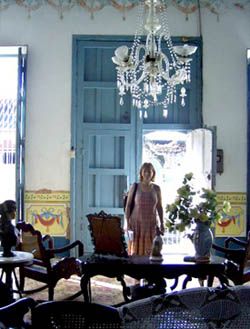
 We
are heading for the colonial town of Trinidad, now a World
Heritage Site. Trinidad was founded by pirates in the early
16th century, but its golden age came with sugar plantations
in the 1700s. When slavery ended, the town fell into decline
but the colonial architecture survived and many buildings
have now been restored. We
are heading for the colonial town of Trinidad, now a World
Heritage Site. Trinidad was founded by pirates in the early
16th century, but its golden age came with sugar plantations
in the 1700s. When slavery ended, the town fell into decline
but the colonial architecture survived and many buildings
have now been restored.
Our
driver drops us at a sky-blue ‘casa particular’, an 18th
century sugar-planter’s house. Our landlady, Yolanda,
answers the door wearing a nightie and slippers, and
welcomes us into a se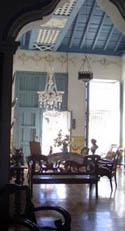 ries of lofty rooms with stenciled
walls, wooden ceilings, chandeliers, and tall windows fitted
with wooden grills instead of glass. The house is crammed
with religious bric-a-brac, plastic flowers and family
mementoes. In our bedroom at the top of a narrow stone
staircase, flimsy drapes billow with each gust of wind, and
the awning on the terrace flaps noisily. A green,
curly-tailed lizard eyes us from the flaking ceiling. ries of lofty rooms with stenciled
walls, wooden ceilings, chandeliers, and tall windows fitted
with wooden grills instead of glass. The house is crammed
with religious bric-a-brac, plastic flowers and family
mementoes. In our bedroom at the top of a narrow stone
staircase, flimsy drapes billow with each gust of wind, and
the awning on the terrace flaps noisily. A green,
curly-tailed lizard eyes us from the flaking ceiling.
We set off to explore the enchanting maze of narrow streets
and leafy plazas, colonnaded courtyards and dilapidated
two-storey houses with startlingly bright stucco and windows
outlined in broad white or terracotta stripes. The town is
often crowded with visitors, but today, after several days
of wind and rain, we are almost the only tourists here. At a
tiny grocery shop, we watch locals hand their ration books
to the elderly shop assistant, and come away with a few
white eggs, a small loaf or a bar of soap.

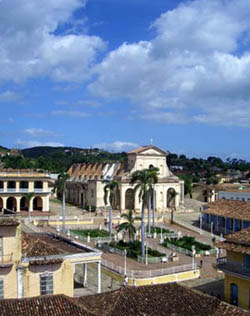 Trinidad’s
main square, the matchless Plaza Mayor, is edged with
pastel-painted colonial houses. White picket fences divide
the central garden from the cobbles. The Museo Romantico is
a two-storey mansion in warm yellow stucco, once owned by a
sugar baron. The interior is furnished as an affluent 19th
century colonial home, with Spanish four-poster beds,
Venetian chandeliers, Bohemian glass, Wedgewood and Meissen
china, as well as local woodcarving, painted friezes and
white embroidered linen. In the kitchen, blackened pots sit
on the charcoal grate, and a stone water filter stands in a
wooden cupboard. Trinidad’s
main square, the matchless Plaza Mayor, is edged with
pastel-painted colonial houses. White picket fences divide
the central garden from the cobbles. The Museo Romantico is
a two-storey mansion in warm yellow stucco, once owned by a
sugar baron. The interior is furnished as an affluent 19th
century colonial home, with Spanish four-poster beds,
Venetian chandeliers, Bohemian glass, Wedgewood and Meissen
china, as well as local woodcarving, painted friezes and
white embroidered linen. In the kitchen, blackened pots sit
on the charcoal grate, and a stone water filter stands in a
wooden cupboard.
 The Museo Histórico Municipal was once the home of another
sugar-baron, who inherited a fortune by killing a
slave-trader, marrying his widow and then murdering her too.
The house has lofty rooms with intricate wall paintings.
From the tower, we get magnificent views over the jumble of
roofs, corrugated iron awnings, washing lines and water
tanks, and into tiny courtyards where women are doing
laundry, cooking on outdoor ovens and serving meals to their menfolk. The sound of ‘son’ rises from a scrubby yard, where
a group of musicians has gathered under the trees. Beyond,
to the south, stretches the shimmering silver Caribbean, and
to the north rise the wooded slopes and knobbly ridges of
the Guamuhaya mountains. The Museo Histórico Municipal was once the home of another
sugar-baron, who inherited a fortune by killing a
slave-trader, marrying his widow and then murdering her too.
The house has lofty rooms with intricate wall paintings.
From the tower, we get magnificent views over the jumble of
roofs, corrugated iron awnings, washing lines and water
tanks, and into tiny courtyards where women are doing
laundry, cooking on outdoor ovens and serving meals to their menfolk. The sound of ‘son’ rises from a scrubby yard, where
a group of musicians has gathered under the trees. Beyond,
to the south, stretches the shimmering silver Caribbean, and
to the north rise the wooded slopes and knobbly ridges of
the Guamuhaya mountains.

 The Church of the Holiest Trinity is locked for most of each
day, but luckily we find a volunteer with a bunch of keys.
The church’s twelve side-chapels each have a wooden altar
intricately carved from local timber. In one, a rare seated
Jesus mournfully awaits crucifixion, his knees bleeding
after dragging the cross to Calvary. Another side-chapel
contains the miraculous Jesus of the True Cross - looted by
local pirates from a ship wrecked on its way from Spain to
Mexico. My favourite is a carved scene of the region’s most
revered saint, the mulatta Madonna of Charity, saving three
fishermen in a storm at sea. Legend has it that this miracle
occurred in 1628. The fishermen - an African, a native
American and a Spaniard, illustrate Cuba’s multi-cultural
heritage. The Church of the Holiest Trinity is locked for most of each
day, but luckily we find a volunteer with a bunch of keys.
The church’s twelve side-chapels each have a wooden altar
intricately carved from local timber. In one, a rare seated
Jesus mournfully awaits crucifixion, his knees bleeding
after dragging the cross to Calvary. Another side-chapel
contains the miraculous Jesus of the True Cross - looted by
local pirates from a ship wrecked on its way from Spain to
Mexico. My favourite is a carved scene of the region’s most
revered saint, the mulatta Madonna of Charity, saving three
fishermen in a storm at sea. Legend has it that this miracle
occurred in 1628. The fishermen - an African, a native
American and a Spaniard, illustrate Cuba’s multi-cultural
heritage.
 Orna and I stop at a
Taberna for papaya milkshakes and
guava-filled pastries, and enjoy an impromptu performance by
locals on drums and maracas. A rusty old American car
lurches past, belching black exhaust. We wander on, peeping
into courtyards and alleys. Inside one doorway, white-robed
devotees are placing offerings at a Santería altar. This
curious Cuban religion blends African tribal beliefs with
the Catholicism of Spanish plantation owners. On the altar,
a black doll is surrounded by symbolic offerings of blood,
rum, food and water – this is Yemayá, a black Madonna,
goddess of the sea and mother of all other deities. Orna and I stop at a
Taberna for papaya milkshakes and
guava-filled pastries, and enjoy an impromptu performance by
locals on drums and maracas. A rusty old American car
lurches past, belching black exhaust. We wander on, peeping
into courtyards and alleys. Inside one doorway, white-robed
devotees are placing offerings at a Santería altar. This
curious Cuban religion blends African tribal beliefs with
the Catholicism of Spanish plantation owners. On the altar,
a black doll is surrounded by symbolic offerings of blood,
rum, food and water – this is Yemayá, a black Madonna,
goddess of the sea and mother of all other deities.
 We pass a school, where children in blue and red
neckerchiefs jostle at a window, staring at us and reaching
through the bars. A teacher beckons us in, and proudly shows
us the shabby concrete classrooms where rows of uniformed
children are copying from blackboards, chanting in unison,
or performing eurythmic exercises. On every wall hang
posters of Che Guevara, whom pupils pledge, each day, to
emulate. We pass a school, where children in blue and red
neckerchiefs jostle at a window, staring at us and reaching
through the bars. A teacher beckons us in, and proudly shows
us the shabby concrete classrooms where rows of uniformed
children are copying from blackboards, chanting in unison,
or performing eurythmic exercises. On every wall hang
posters of Che Guevara, whom pupils pledge, each day, to
emulate.
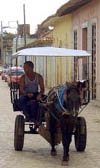 Later, we hail a taxi-carriage and the horse sets off at a
trot over the huge uneven cobbles, as we slither and bounce
on the wooden seat under the canopy. The streets are free of
dung because horses wear effective canvas nappies. Our cart
hits a skinny dog, which yelps and scuttles to safety. Later, we hail a taxi-carriage and the horse sets off at a
trot over the huge uneven cobbles, as we slither and bounce
on the wooden seat under the canopy. The streets are free of
dung because horses wear effective canvas nappies. Our cart
hits a skinny dog, which yelps and scuttles to safety.
We pass makeshift stalls selling fly-strewn slabs of pork,
wheelbarrows of brown bananas, young girls sitting by
baskets of herbs, pizzas cooking in charcoal ovens, and an
old woman dragging a black piglet on a string. Locals crouch
on doorsteps, men in straw hats, women in colourful turbans,
enjoying the cool breeze. The streets are lined with
one-storey houses, the once-vibrant yellow, blue, green or
pink stucco peeling and flaking. From this vantage point, we
can see through window grids into dark, sparsely-furnished
front rooms.
 The
horse halts outside a tobacco factory, a grim, open-sided
sweatshop where rows of workers – mainly women – produce fat
cigars, rolling a blend of tobacco in a binder leaf,
pressing in wooden racks, and gluing a soft outer layer of
fine leaves, specially grown under cheesecloth. From a
lectern at the front, a worker is reading aloud – state news
in the morning, and literature in the afternoon. Brands of
Cuban cigars are sometimes named after books that the
workers have enjoyed – Romeo y Julieta, or Montecristo. The
horse halts outside a tobacco factory, a grim, open-sided
sweatshop where rows of workers – mainly women – produce fat
cigars, rolling a blend of tobacco in a binder leaf,
pressing in wooden racks, and gluing a soft outer layer of
fine leaves, specially grown under cheesecloth. From a
lectern at the front, a worker is reading aloud – state news
in the morning, and literature in the afternoon. Brands of
Cuban cigars are sometimes named after books that the
workers have enjoyed – Romeo y Julieta, or Montecristo.
As dusk falls, we stand on the breezy terrace outside our
bedroom, listening to the sounds of dogs barking, car horns
beeping, children calling, the rattle of homemade go-karts
on the cobbles, the judder of a motorbike and chickens
clucking. Palm trees jut above the red and yellow roofs.
Small birds dart through the violet sky, as distant hills
darken to a misty grey.
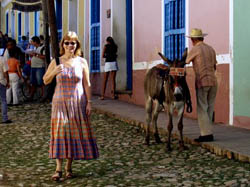 Yolanda cooks us supper – thin soup dotted with chunks of
potato, a whole red snapper with fried plantains, yucca,
rice and beans, and, for pudding, a dusty pink jelly made
from local guavas, served with salty curd cheese. Yolanda cooks us supper – thin soup dotted with chunks of
potato, a whole red snapper with fried plantains, yucca,
rice and beans, and, for pudding, a dusty pink jelly made
from local guavas, served with salty curd cheese.
After supper, Orna and I venture out again, following the
throb of ‘son’ music through the cobbled streets to a small
plaza by the Casa de Musica. Here we find hundreds of locals
dancing to a nine-piece band, a crumbling stucco wall behind
them forming an artistic backdrop. The atmosphere is
electric. Elderly gentlemen in natty suits and white shoes
perform passionate salsas with their snowy-headed wives, and
younger dancers throw their partners with elegance, abandon
and skill. We find an empty table at the open-air café and
order mojitos - gaudily striped green, white and red rum
cocktails garnished with mint.
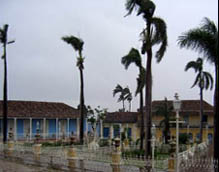 The wind is getting up, and twice a power-cut plunges us
into darkness. But the musicians continue undaunted, as
spectators light flickering cigarette lighters or small
torches. At first reluctantly, and then more confidently,
Orna and I dance with an assortment of partners, old and
young, groping our way back to our table with each blackout.
The lights are still out at midnight as we stumble over the
cobbles to Yolanda’s, and candles light us to bed. Wind and
rain rage until dawn, and in the morning the electricity is
still off, the flowerpots on the terrace have crashed on to
their sides, and there is no water in the taps. The wind is getting up, and twice a power-cut plunges us
into darkness. But the musicians continue undaunted, as
spectators light flickering cigarette lighters or small
torches. At first reluctantly, and then more confidently,
Orna and I dance with an assortment of partners, old and
young, groping our way back to our table with each blackout.
The lights are still out at midnight as we stumble over the
cobbles to Yolanda’s, and candles light us to bed. Wind and
rain rage until dawn, and in the morning the electricity is
still off, the flowerpots on the terrace have crashed on to
their sides, and there is no water in the taps.
But outside, Trinidad glistens like a polished gem. The sun
is shining from an azure sky, and a fresh breeze brushes our
cheeks. The storm has passed.
First published by the Telegraph
©SarahShuckburgh |